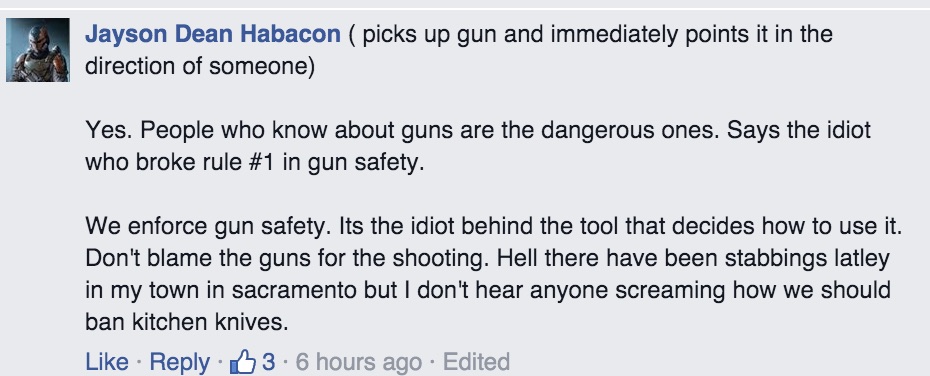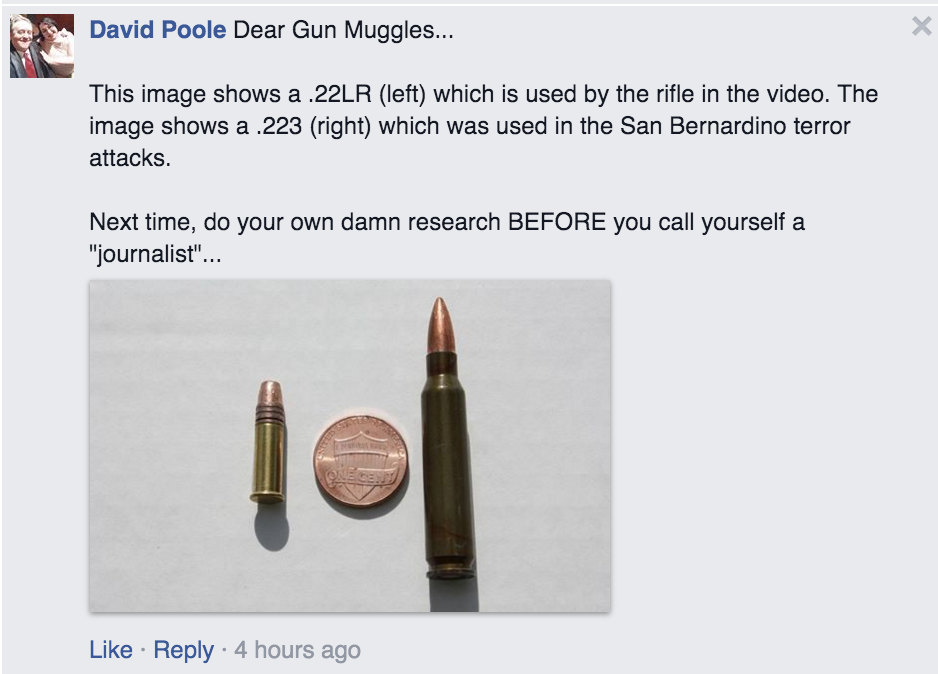A video produced by the Guardian has generated more than a million Facebook views and a lot of heat from critics.
Last week at SHOT Show, the nation’s largest gun trade show, The Guardian’s Mae Ryan and Rupert Neate were escorted out of a convention center in Las Vegas after they asked a Smith & Wesson representative whether a gun on display was the same model as the one used in December’s mass shooting in San Bernardino, California.
While the video makes for interesting viewing, in my judgment, the story isn’t fair. It was theatrics masquerading as even-handed reporting. From the very beginning of the video, it was clear the journalists counted on causing a stir on the convention floor.
SHOT Show is a big deal for the gun industry. With 64,000 attendees, 1,600 exhibitors covering 13 acres of convention space 12.5 miles of aisles, it has grown into Las Vegas’ fifth-largest trade show. Gun manufacturers, retailers and equipment suppliers for hunters and law enforcement professionals packed the Sands Expo Center last week.
They were joined by hundreds of journalists. More than 2,500 members of the media were expected at this year’s convention and were met by organizers who are highly sensitive to anti-gun coverage. The National Shooting Sports Foundation, which organizes the convention, says it considered the following before granting press credentials:
- Previous media credentialing at one or more recent SHOT Shows, or invitation to receive 2016 credentials (both subject to re-qualification review).
- Demonstrated record of print, broadcast, cable or web-based coverage of shooting, hunting, law enforcement and related activities.
- Because the SHOT Show is run for the benefit of the shooting, hunting, outdoor and law enforcement industry, a demonstrated record of reasonable objectivity, fairness and balance in past coverage of the industry will be considered.
The foundation told The Guardian reporters they would be allowed into SHOT Show but would be escorted by a convention worker. In a phone interview, Neate told me he understood and agreed to the stipulation.
Neate says that when he arrived at the show, it wasn’t clear where he should to go to find an escort, so he and Ryan toured the convention floor on their own. His on-camera narration seemed to indicate he knew there might be trouble from the start — in the beginning of the video, he notes that the journalists have been “asked by the organizers not to mention the issue of gun control with gun companies.” He adds, “We’ll see how that goes.”
Neate then begins his trek through the displays. He points a rifle, apparently aiming at somebody, and says, “wow, you can see that guy. It’s quite scary.” He interviews a man with spiked purple and blue hair who says his gun sales are up 60 percent and a woman who says her sales (we don’t know what she is selling) are up threefold. He talks to a woman who, with her fiancé, own 200 guns. The camera focuses on a display of a woman’s underwear that the wearer can use to hide a gun.
Contrast his interview with the guy in purple spiked hair with SHOT Show’s photos of hundreds of convention attendees, and you have to wonder how The Guardian chose the characters it used in the story. “I don’t choose the people I interview according to the color of their hair,” Neate said. But the man’s bad boy look sets an unflattering tone for the story.
Neate wanders over to the Smith & Wesson display and listens as the company rep demonstrates a new line of pistols and the new M&P15 22 sport. The name is important because this is a .22 caliber rifle, not a high powered assault weapon — even though it looks like one. Those .22 caliber weapons are the kind of guns that those of us who grew up in the country might use for shooting soda cans. Neate awkwardly shoulders the weapon and asks if it’s the same gun used in the San Bernardino shooting. The Smith & Wesson spokesman clarifies that it is a .22 long rifle weapon, we see an edit and the interview ends. Neate should have known the difference between the .22 caliber rifle he was holding and the higher-powered .223 AR-15 used in the shooting. That weapon had been modified to attempt to turn it into an illegal fully automatic rifle.
The next scene shows Neate sitting at a table reading an email from a SHOT Show representative asking him to come to the convention office right away. “I don’t think he liked our question about the San Bernardino massacre,” he says of the Smith & Wesson representative.
The Guardian rolls video while a convention official, Bill Brassard, politely scolds Neate before security arrives to walk the team out of the hall. Neate feigns confusion about why he is being tossed out. While he walks out, he says to the camera that he is being ejected because “gun control is a hot topic at the moment, but it appears you can’t ask the gun industry about it.”
Neate told me the position of The Guardian’s editorial writers on guns is clear. “We are anti-guns. We are ‘pro’ the most severe gun control there could be.” When I asked him if he thought his reporting reflected that opinion, he said it didn’t. He said there is no editorializing in his video.
I disagree.
When you read The Guardian’s text version of the story, you’ll notice it has a tone similar to the video. The headline says “Sex, guns and ammo: inside the world’s largest gun industry trade fair.” The story links mass shootings and talk of gun control with surging gun sales after each high-profile shooting. It includes this passage:
“People are buying guns as part of the American dream of freedom and liberty,” said Brauer, who is based at the Hull College of Business at Augusta University. “And also, the hope and the dream of being able to use guns in self-defence.”
People very rarely get to live out that dream, with FBI data showing that gun owners are 78 times more likely to kill themselves than they are to carry out a “justifiable homicide”, which the agency describes as “the killing of a felon, during the commission of a felony, by a private citizen”.
Very rarely? The federal government’s data says gun owners use their weapons for self-defense 67,740 times a year.
Neate told me that he attended the show to “try to learn about the gun industry.”
“It was a business story about how the gun industry is doing a lot better after each gun shooting and in the wake of gun control talk,” he said. Those are legitimate story angles, to be sure.
But many of the more than 1,000 comments attached to the story are not critical of gun advocates. They are critical of the reporter who broke key safety rules and by doing so revealed a lack of expertise on the subject he was covering. In one instance, he aimed a weapon at someone. He also put his finger on the trigger of another rifle. Even novices learn the first rule in handling a gun safely is to treat it as if it were loaded and never point it at anybody.

Other commenters remarked that Neate didn’t seem to understand the differences between calibers.



The Guardian is right about one thing. Guns are a hot topic. And some journalists have covered it aggressively in ways that bring real understanding and spark meaningful conversations.
The St. Louis Dispatch explored ammo sales, The Washington Post spent a year tracking “The Hidden Life of Guns” and USA TODAY created a myth-busting interactive about mass killings in the U.S. called “Behind the Bloodshed.”
Journalists should go after stories about how to control gun violence, about the influence gun manufacturers have over lawmakers and whether gun manufacturers should be liable for damages in shootings, as some politicians are suggesting. But when journalists tackle contentious issues, they have an obligation to develop expertise about the story they are reporting. They build trust with sources on all sides of the story. The more you know about a subject, the more aggressively you can pursue it.
Serious subjects require serious reporting. Not self-serving stunts.







